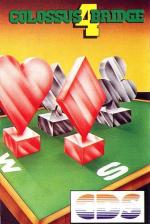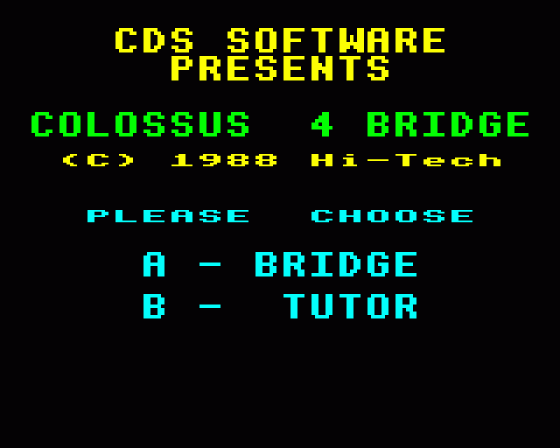
Beebug
 1st March 1989
1st March 1989
Categories: Review: Software
Author: Sheridan Williams
Publisher: CDS
Machine: BBC/Electron
Published in Beebug Volume 7 Number 9
Colossus Bridge 4
Colossus Bridge 4 comes on a 40-track DFS disc, or a tape, and is accompanied by the paperback book Begin Bridge by G.C.H. Fox.
Unlike Chess, Bridge seems to suffer a dearth of good computer versions of the game. Colossus Bridge 4 remedies this situation, and is available for the Spectrum, Commodore, Amstrad, PC compatibles (with CGA card), the BBC Model B, B+, Master, Compact and Electron. The package really is jolly good, and I would encourage you to read on beyond some of my more negative initial comments.
Unfortunately, BBC and even Master users have machines with insufficient memory to make available features such as saving and loading a game, backstepping the play, demonstration mode, on-line instruction menu, and listing the deal to a printer. Nevertheless, several useful features remain:

During the Play: 1. Autoplay a card 2. Claim remaining tricks 3. Recommend a card 4. Abandon the hand
At end of Game: 1. Replay a hand 2. Input a hand 3. Start a new rubber 4. Set distribution of hand 5. Set the playing speed
CDS Software says: "Colossus allows one player to play a complete game of Bridge with the computer controlling the other three hands. Each hand is bid according to the Acol system, with Blackwood, Stayman and Baron conventions being used. The strong two club, and take-out doubles are also supported. All four hands are displayed at the end of play."

So how does the package live up to expectations? Well, judging by the manual (not the free book Begin Bridge, of which more later) you would be rather disappointed. The manual is tiny, measuring only 100mm x 130mm and contains only thirteen pages. It tries to cover all the features on all the computers listed earlier. Although typeset, only one typeface and font size is used, and this tends to make headings and other important features get lost, resulting in a pretty difficult-to-follow manual. Amazingly, once you have used a "highlight" pen to mark headings and relevant sections, the manual is quite a useful summary if treated like a reference card.
The Book
CDS has, very wisely, chosen to supply the book Begin Bridge by G.C.H. Fox to augment the manual, reasoning that there is no point in their manual attempting to teach you how to play when there have been suitable books around for ages. I would concur with The Observer's Terence Reese when he says "A clear and reliable introduction for the complete beginner," although I would go further and say that it caters for more than the beginner, and is an excellent book to read if your Bridge is a little rusty. Pity it has no index.
The Program
On most computers other than the BBC/Master range, the package allows you to change the screen colours. Unfortunately, the standard colours make playing on a green screen monochrome set virtually impossible, whereas on a colour screen I found the colours pretty much ideal. Up to now I may have sounded very negative about the package, but as I said earlier you should read on.
Bridge is divided into two parts - the bidding and the play: each requiring skills in its own right. If anything, I personally prefer the bidding to the play. It involves a quite separate challenge of communicating with your partner, listening to the opponents' bids, and weighing up the statistical evidence to arrive at a contract. Although you may not know it until after the play, it is most satisfying if you have bid the best contract. Colossus Bridge caters well for those who like bidding.
Once the package has been auto-booted into action, you are prompted for a playing speed from 0 to 28. This sets the delay between each bid, and also the delay between each card being played. I found that 15 was appropriate in most instances. The package makes abundant use of the space bar, the moral being "if in doubt press space".
The Bidding
The current state of vulnerability, the dealer, your high-card point count (face cards only, not distribution), current score (below the line), and hand number, are displayed at the top of the screen. Being South your hand is displayed at the bottom of the screen, you are always South, this cannot be changed. The bidding is displayed at the left of the screen with the selected delay between bids. It is very easy to enter a bid, the convention being fairly natural, 1 Spade is 1S, 4 Clubs is 4C, 3 No Trumps is 3N, Double is D, Redouble is R, and Pass is the ubiquitous space bar. Unless specified at the end of each game, the next hand is randomly generated.
As has been said before bidding follows the Acol system, with Blackwood, Stayman and Baron conventions. Within reason you can trust the computer's bids, whether it is bidding as your partner or as the opposition. Its bidding is defined in the manual, however it does get confused on some very unusual hands, but in general it won't make beginner's mistakes such as passing a 2-club opener, or opening with the lower ranking of two suits of equal length (and for those of you who know - yes, it does know what to do if the suits are spaces and clubs, or it has a 4441 distribution).
The Play
As you would expect, in some hands North/South end up in a contract, in others East/West end in a contract and you are in opposition. Either way it is good to think for a while before playing a card, as once chosen, you cannot retract the card on the BBC/Master as you can on other computers. However, on the Master you can ask the computer to recommend a card. The computer plays well, making sensible decisions on most occasions. Opening leads are defined in the manual, but to give you a flavour this is what it says "Parner's bid suit, top of a 3 card honour sequence, Ace from AK, King from KQ, 4th highest of longest suit (no trumps), singleton or high-low from a doubleton. If sensible, partner's lead will be returned."
The Tutor
This contains a series of ten hands illustrating the fundamental principles of the game. On each hand the player must enter the correct pre-determined bid and then play the hand before seeing a description and analysis.
The tutor is disappointingly in black and white, and it would be nice to see the hand again after the analysis. Hand 6 gets N/S and E/W confused in the analysis. I found overall that I could have done with more than 10 hands. Treat the Tutor as a bonus and you won't be disappointed.
Conclusion
If, like me, the opportunities for playing Bridge are insufficient to meet your craving, Colossus Bridge will at least give you a game. During play however, it cannot meet anything other than the immediate problem. For instance, it cannot anticipate impending problems such as the lead being in the wrong hand, end-play, etc. It plays according to the rules in the manual, so at least you know where you are. I found it great fun, and have been back and used it many times. For its price I cannot do anything other than recommend it, especially if you are a beginner.






